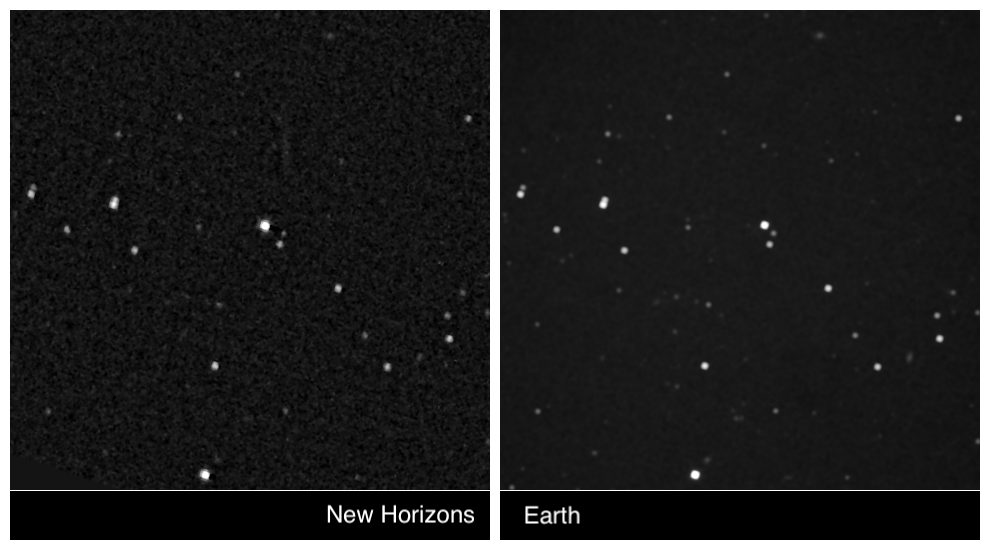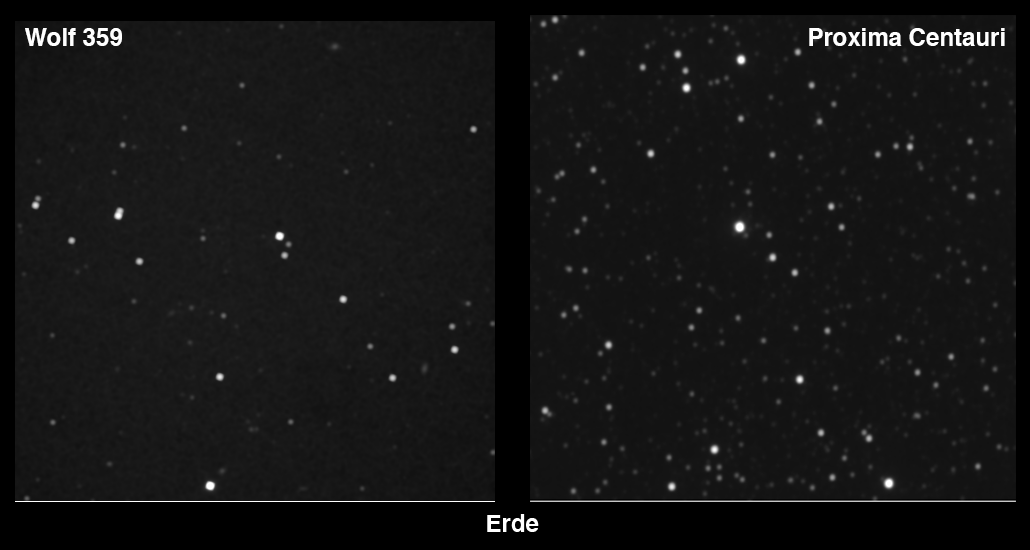The New Horizons spacecraft is humanity’s fastest-moving spacecraft and headed to interstellar space. Since its exploration of Pluto 10 years ago and subsequent flyby of Arrokoth in 2019, it’s been traversing and studying the Kuiper Belt while looking for other flyby objects. That’s not all it’s been doing, however. New Horizons also has an extended program of making heliophysics observations. The mission science team has also planned astrophysical studies with the spacecraft’s instruments. Those include measuring the intensity of the cosmic optical background and taking images of stars such as Proxima Centauri. As the spacecraft moves, the apparent positions of its stellar navigation targets have changed, but that hasn’t bothered New Horizons one bit. It knows exactly where it is thanks to 3D observations of those nearby stars.
A recent paper released by the team of scientists connected to the New Horizons mission (see references) presents the startling change in parallax view that the spacecraft provided. New Horizons has achieved a breakthrough: the first time optical stellar astrometry has been performed as a way to get the three-dimensional location of a spacecraft with respect to nearby stars. It’s also the first time any method of interstellar navigation has been demonstrated for a spacecraft on a trajectory out of the Solar System. The paper’s conclusions suggest that future spacecraft heading out into the wider galaxy would do well to use a single pair of nearby stars in an astrometric approach to navigation.
Navigation by the Stars
Using the stars for navigation isn’t a new idea. People have done it on Earth throughout history, getting across the continents, sailing the seas, and more lately, traveling in the Solar System. Still, navigational methods rely on Earth-centered measurements along with star-sighting techniques. For example, the Voyager spacecraft, the Hubble Space Telescope, and others have star trackers to help keep them in the proper attitude and on course (in the case of Voyager and New Horizons). What happens when you (or your spacecraft) leave the Solar System? In science fiction books, movies, and TV shows, starships fly hither and yon, such as the spacecraft in the Star Trek universe. They use a combination of galactic databases, so-called “subspace sensors”, and other advanced methods to warp their way through the Milky Way (and beyond). The methods might look familiar to us today, even if the technology doesn’t.
The New Horizons mission teams used optical navigation techniques to guide the spacecraft to Pluto and Arrokoth. These include an onboard camera to take images of the targets (Pluto, Charon, etc.) against a backdrop of reference stars, as well as image processing techniques. Once it leaves the Solar System behind, the spacecraft will rely on interstellar navigation methods using the same optical navigation practices. The team’s paper describes the challenges in doing that. They state, “Besides needing to know what direction we’re headed in, we will also need to know how far we’ve traveled. Our motion will appear to shift the positions of nearby stars with respect to more distant ones—and that will tell us how far we’ve gone. We can demonstrate this with images obtained by NASA’s New Horizons spacecraft on 2020 April 22-23, when it was then 47 AU distant from the Sun, passing through the Kuiper Belt.”
In other words, the images and measurements of distant stars and their parallaxes will allow spacecraft operators to triangulate mission positions quite accurately. So, in the future, if time, money, fuel, and equipment were in infinite supply, New Horizons could be guided toward stellar targets. Conceivably, if it had the ability to make its own travel plans, it could take itself anywhere it (or its designers) wanted it to go, including to the nearest star in our neck of the Galaxy: Proxima Centauri.
It’s About Parallax
This figure illustrates the phenomenon of stellar parallax. When New Horizons and observers on Earth observe a nearby star at the same time, it appears to be in different places compared to more distant background stars—this is because New Horizons has traveled so far out in space that it has to look in a different direction to see that star. Credit: Pete Marenfeld, NSF’s National Optical-Infrared Astronomy Research Laboratory
Anyone who’s taken an astronomy class learned about parallax measurements by holding a finger up and looking at something in the distance with one eye at a time. When you do that, the position of the finger changes as you blinked back and forth. Using Earth’s motion throughout the year with respect to distant objects also can approximate parallax on a grander scale. Real parallax measurements require observing a star for a number of years to measure its apparent motion against the backdrop of more distant ones. The end result gives a parallax “view” that looks like a change in the star’s proper motion. Finally, even the nearest stars have tiny parallaxes. Interestingly, Pluto itself was found using this “positional shift” by Clyde Tombaugh in 1930. He took images of the sky where Pluto was thought to be and then viewed them through a “blink comparator” to detect its motion against the stars (and as Earth moved in its orbit).
Some 76 years after Tombaugh’s discovery, the New Horizons mission set out for the Pluto system. The spacecraft depended on optical navigation and a Jupiter assist to get it out to the correct spot in the Kuiper Belt. Finding Pluto was a challenge, since its orbit was only tracked for about a third of its time and that induced some uncertainty in its exact location. New Horizons had a general sense of Pluto’s position, and that location was tweaked by feedback from the optical navigation system as the spacecraft approached. As New Horizons’s position changed throughout flight, the positions of its guide stars (and targets) appear to change, as well, in a fine demonstration of parallax shift.
Presently, New Horizons is just over 62 AU from Earth—that’s its Earth-spacecraft (ES) baseline. On April 22-23, 2020, when the spacecraft was about 42 AU away, the New Horizons team used the LORRI (Long-range Reconnaissance Imager) camera to image the star fields containing the nearby stars Proxima Centauri and Wolf 359. At that time, it was the largest such baseline made to that date. These measurements, although not as accurate as those made by Gaia, for example, are still useful to show how parallax works using real objects in space.
 For this view of the parallax of Wolf 359, cross your eyes until the pair of images merges into one. It might help to place your finger or a pen just a couple of inches from your eyes, and focus on it. When the background image comes into focus, remove the closer object and concentrate on the image. Credit: NASA/Johns Hopkins Applied Physics Laboratory/Southwest Research Institute/John Spencer/University of Louisville/Harvard and Smithsonian Center for Astrophysics/Mt. Lemmon Observatory
For this view of the parallax of Wolf 359, cross your eyes until the pair of images merges into one. It might help to place your finger or a pen just a couple of inches from your eyes, and focus on it. When the background image comes into focus, remove the closer object and concentrate on the image. Credit: NASA/Johns Hopkins Applied Physics Laboratory/Southwest Research Institute/John Spencer/University of Louisville/Harvard and Smithsonian Center for Astrophysics/Mt. Lemmon Observatory
The shifts in position measured with simultaneous Earth and New Horizons observations are a significant fraction of an arcminute for the nearest stars. If you look at the Earth-based images of the spacecraft’s target stars and compare them to the New Horizons images, it’s fairly easy to see the displacement of the targets against the backdrop of more distant stars. This method is actually a pretty good analog to the astronomy class experiment of holding your finger up and looking at it while blinking your eyes.
What’s Next?
The New Horizons parallax experiment was a big first step in learning the techniques of stellar navigation. If it’s used to make these measurements again, the team suggests taking a larger number of images to get better measurements of stellar positions. That would make good use of the only asset currently exploring the Kuiper Belt, which is turning out to be way more interesting than expected. New Horizons is expected to exit the Kuiper Belt late in this decade and has enough fuel to power it through the 2030s. Whether or not the mission gets cut off by NASA after it leaves the Kuiper Belt is an open question at this time.
Future spacecraft to visit the outer Solar System and beyond will be designed with autonomous (self-guiding) navigation technology, particularly coupled with improvements in imaging and image processing, along with applications of artificial intelligence. In addition, while using stars is a good baseline, radio and X-ray pulsar measurements could improve navigation. These rely on a known database of such objects and have also been suggested for navigation purposes here on Earth. In space, those measurements will supply much more accurate data, not just about the pulsars, but about the exact position in space of the craft taking them.
For More Information
A Demonstration of Interstellar Navigation Using New Horizons
Optical Navigation Preparations for New Horizons Pluto Flyby
Star Trek Navigation
